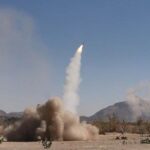
While trying to assert its commitment to strategic autonomy, the European Union is poised to establish an independent naval operation safeguarding commercial shipping in the Red Sea. This move signifies a divergence from acting solely under the umbrella of the United States, showcasing the EU’s desire for self-directed initiatives. Despite past objections, Spain has withdrawn its opposition, paving the way for further deliberations on the plan’s specifics.
The EU foreign ministers’ meeting on Jan 22 has finally given a green signal to this plan, with Italian Foreign Minister Antonio Tajani emphasising the urgency of creating an operational European mission. Although the final go-ahead is expected at the next EU Foreign Affairs Council, but Tajani appears to be quite enthusiastic about this plan.
“We are proposing along with France and Germany a mission that can guarantee the safety of maritime traffic,” Tajani told media. In detailing the forthcoming expansion of the Emasoh/Agenor mission, he further clarified its defensive nature, signaling the EU’s strategic commitment to safeguarding vital interests in the Strait of Hormuz.
The use of military force, though incorporated, remains strictly circumscribed within defensive parameters, aligning with the union’s nuanced approach to regional security. This development underscores the EU’s pursuit of a distinct role in global affairs.
In the aftermath of U.S.-led air strikes on Houthi targets in Yemen, 10 nations, including EU members Denmark, Germany, and the Netherlands, pledged joint support in safeguarding the vital passage through the Red Sea. However, acknowledging the imperative for the EU to strengthen its influence, a majority of EU member states advocate for a unified initiative that operates independently, free from the influence of Washington’s shadow. This cooperative effort signals the EU’s intent to tackle these challenges autonomously.
Factually speaking, committing to a U.S.-led operation in the Red Sea for shipping security implies subordination to U.S. directives. The EU must carefully weigh aligning with U.S. ‘interests’ against its own priorities in the crisis. A nuanced evaluation of collaboration is crucial, ensuring that joint efforts are driven by shared objectives rather than becoming mere instruments for advancing external agendas. The EU’s existing autonomous maritime security initiative, the Atalanta mission in the northwestern Indian Ocean, demonstrates its capability to operate independently.
Choosing not to participate in U.S.-led Red Sea military actions could signal a commitment to resolving tensions stemming from the Gaza conflict through peaceful, political avenues. Addressing the root cause, the Gaza conflict, holds the key to stabilising the Red Sea region. Prioritising diplomatic solutions aligns with the EU’s emphasis on peaceful resolutions and reinforces its distinct approach to maritime security challenges.
The Red Sea’s vital role in global trade necessitates safeguarding commercial shipping, but the U.S.’s use of force exacerbates risks without addressing the core issue. Resolving the Gaza conflict diplomatically is paramount to ensuring stability in the Red Sea region and safeguarding international trade routes.
The Red Sea’s stability is indispensable for sustaining seamless global trade and economic interconnectedness. Amidst rising tensions in the Red Sea, the Houthi rebels’ declaration to target ships connected to Israel has triggered a swift and concerning response from the United States. Rather than pursuing diplomatic avenues, the U.S. has opted for escalation, initiating a multinational coalition against the Yemeni militants. Subsequently, the U.S. and UK militaries took matters into their own hands, launching strikes on Houthi-controlled territories in Yemen.
Unfortunately, these military operations have so far failed to halt the Houthi attacks on shipping, further intensifying the conflict. In an unexpected turn, the Houthi rebels retaliated by targeting a U.S.-owned and operated cargo ship with an anti-ship ballistic missile. This escalation raises critical questions about the effectiveness and strategic rationale behind the U.S. response. Instead of quelling the threat, the escalated actions seem to have fueled further hostilities, underscoring the complexities of the situation in the Red Sea and the challenges in finding a resolution that ensures regional stability and protects international shipping interests.
The tit-for-tat dynamics in the Red Sea are rapidly escalating, revealing a miscalculation of the Houthis’ military capabilities by the U.S. and the UK. Experts suggest that containing the Houthis by such haphazard missile attacks on targets in Yemen will pose significant challenges for the U.S., indicating a prolonged and unresolved crisis in the Red Sea.
The ongoing retaliation and counter-retaliation paint a complex picture, underscoring the intricacies of the situation and the difficulty in finding a swift resolution to the growing tensions in this crucial maritime region. By refraining from participation in U.S.-led military endeavors in the Red Sea, the EU signals a preference for peaceful, political resolutions to the tensions stemming from the Gaza conflict. While safeguarding the Red Sea’s role in global trade remains paramount, the U.S. reliance on force exacerbates risks rather than offering a comprehensive solution.
A nuanced approach that tackles the underlying issues, particularly the Gaza conflict, is essential for lasting stability and security in the Red Sea region.













